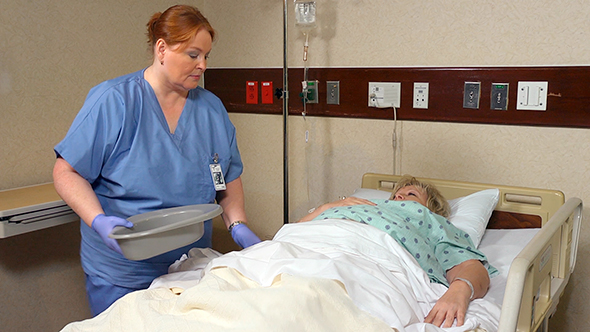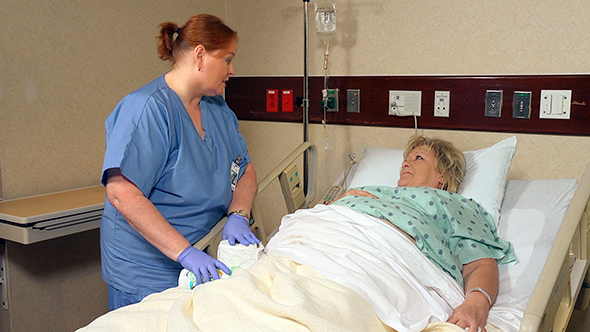Elimination Assistance
Select a Skill:
- » Helping the Person to the Commode
- » Applying Incontinence Products
- » Giving the Urinal
- » Giving the Bedpan
- » Applying a Condom Catheter
- » Giving Catheter Care
- » Emptying a Urinary Drainage Bag
- » Changing a Leg Bag to a Drainage Bag
- » Giving an Enema
- » Changing an Ostomy Pouch
Take the Review Test:

Purpose

- Bedpans are used for elimination for persons who cannot be out of bed. Women use bedpans for voiding and bowel movements (BMs). Men use them for BMs.
- A standard bedpan has a wide rim that is placed under the buttocks.
- A fracture pan has a thin rim. It is only about ½-inch deep at one end. The smaller end is placed under the buttocks. Fracture pans are used:
- By persons with casts
- By persons in traction
- By persons with limited back motion
- After spinal cord injury or surgery
- After a hip fracture or hip replacement surgery
- Like a fracture pan, a bariatric bedpan has a small end that is placed under the buttocks. Some have a weight capacity of 1,200 pounds.
Equipment
Roll cursor over items to see labels. For the purposes of clearly depicting the equipment, a barrier is not shown in this photo. When providing care, a barrier should always be placed on the surface before placing the equipment.

Standard bedpan
Fracture pan
Toilet tissue
Hand wipes
Hand towel
Waterproof pad
Delegation
- Follow delegation guidelines. Before giving the bedpan, obtain this information from the nurse and care plan:
- What bedpan to use—standard bedpan, fracture pan, or bariatric bedpan
- Position or activity limits
- If you can leave the room or if you need to stay with the person
- If the nurse needs to observe the results before disposing of the contents
- What observations to report and record
- When to report observations
- What patient or resident concerns to report at once
Preparation

- Observe quality-of-life measures.
- Review the information under Delegation and Safety and Comfort.
- Provide for privacy.
- Practice hand hygiene.
- Put on gloves.
- Collect the equipment.
- Arrange equipment on the chair or bed.
Safety

- Urine and feces may contain blood and microbes. Microbes can live and grow in dirty bedpans. Follow Standard Precautions and the Bloodborne Pathogen Standard when handling bedpans and their contents. Thoroughly clean and disinfect bedpans after use.
- Remember to raise the bed as needed for good body mechanics. Lower the bed before leaving the room. Raise or lower the bed rails according to the care plan.
Comfort
- Some older persons have fragile bones or painful joints. For them, fracture pans are more comfortable.
- Most bedpans are made of plastic. Those made of metal are often cold. Warm them with warm water and then dry them before use.
- The person must not sit on a bedpan for a long time. Bedpans are uncomfortable and they can lead to pressure ulcers.
Procedure Video
Audio Description: OFFFollow-up Care

- Provide for comfort.
- Place the call light within reach.
- Lower the bed to its lowest position. Raise or lower bed rails. Follow the care plan.
- Unscreen the person.
- Complete a safety check of the room.
- Follow agency policy for soiled linen.
- Practice hand hygiene.
Reporting/Recording
- Report and record your observations, including:
- Urine color, amount, clarity (or cloudiness), and odor
- Particles or blood in the urine
- Complaints of urinary urgency or burning, dysuria, or other problems
- Color, amount, consistency, and odor of feces
- Signs of blood in feces
- Complaints of pain or discomfort with bowel movement
Review Questions
Select the best answer.
1. Which person is most likely to need to use a bedpan?
 A man, age 75, with pneumonia
A man, age 75, with pneumonia A man, age 45, with a fractured pelvis
A man, age 45, with a fractured pelvis A woman, age 56, with congestive heart failure
A woman, age 56, with congestive heart failure A woman, age 69, with early-stage Alzheimer’s disease
A woman, age 69, with early-stage Alzheimer’s disease
Select the best answer.
2. When is a fracture pan used?
 When a person is elderly or obese
When a person is elderly or obese When a person resists using a bedpan
When a person resists using a bedpan When a person cannot assist with positioning
When a person cannot assist with positioning When a person has had a spinal cord injury or surgery
When a person has had a spinal cord injury or surgery
Select the best answer.
3. After placing a person on a standard bedpan, how should you position him or her?
 In the supine position
In the supine position In a side-lying position
In a side-lying position In the Fowler’s position
In the Fowler’s position In the semi-Fowler’s position
In the semi-Fowler’s position
Select the best answer.
4. When helping a person use the bedpan, which safety measure should you take?
 Thoroughly clean and disinfect bedpans once every day.
Thoroughly clean and disinfect bedpans once every day. Always place a waterproof pad under the person’s buttocks.
Always place a waterproof pad under the person’s buttocks. Always keep the bed rails up while the person uses the bedpan.
Always keep the bed rails up while the person uses the bedpan. Follow Standard Precautions and the Bloodborne Pathogen Standard.
Follow Standard Precautions and the Bloodborne Pathogen Standard.
Select the best answer.
5. If the person cannot clean the genital area after using a bedpan, what should you do?
 Wipe the area from front to back.
Wipe the area from front to back. Wipe the area from back to front.
Wipe the area from back to front. Wipe the area with circular motions.
Wipe the area with circular motions. Omit wiping and perform perineal care.
Omit wiping and perform perineal care.
You have completed the Review Questions for this skill. To take the Review again select the Start Over button. To proceed to another skill select from the dropdown menu. Select the Home or Back button to proceed to the next section.

